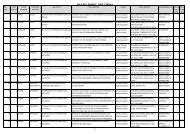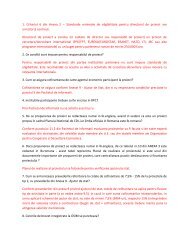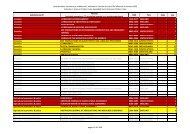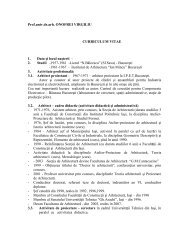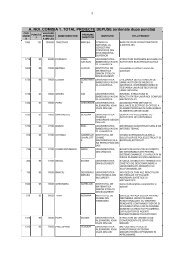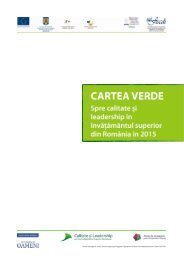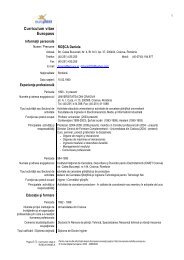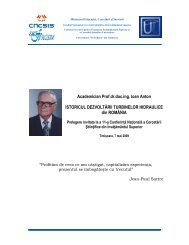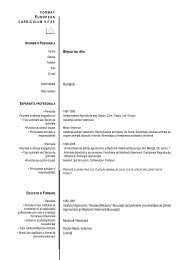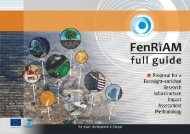Managementul activitatilor tertiare - uefiscdi
Managementul activitatilor tertiare - uefiscdi
Managementul activitatilor tertiare - uefiscdi
You also want an ePaper? Increase the reach of your titles
YUMPU automatically turns print PDFs into web optimized ePapers that Google loves.
"For a technology company like Oxford Catalysts, intellectual property protected by patents is akey asset for building the business"Tiancun Cost: Patent agents and translators Patent office fees, including renewal fees Legal fees if you need to enforce your patent in court Benefit: Essential to attracting investors• Create state-of-the-art facilities• ecruit top scientists• Cover development cost Enables licensing the technology in exchange for royaltiesFurther informationFor further information refer to:http://www.isis-innovation.comhttp://www.oxfordcatalysts.comor contact Terry Pollard:terry.pollard isis.ox.ac.ukThe 3 rd stream activities in direct connection with academic activitiesacademic curricula development according to maret needs (surveys, seminars, worshops, worforcedevelopment programmes)Research evelopment co-operation (achelor, Master, Ph ) student proects, placements3rd party stream impact in academia (new product presentations, practical placement) irect involvement in the everyday life of the universityStudy case examples of how this is done ( egCurriculum oards, Faculty Council)cademic Curricula evelopmentIn countries of the developed world education and scientific research have in most cases been atthe forefront of national development efforts and innovations. Here, there was always closeproximity between ongoing academic efforts and various industrial outcomes. In fact, industrieshad always flourished around colleges and university campusesliving examples in the US includeindustrial parks such as esearch Triangle Park (TP) in North Carolina, and Silicon Valley inCalifornia. It has been through academic research, in great part, that western industries havesustained their pace of growth, where in most cases military research took the lead.Industrial economies have it that in order to lead sustainable growth academic-industrialcollaboration must exist at significant proportions. Under economies like these research budgets,be it directly through the academia or via funding coming in from supporting industries, have hit avisible share in the GNP of the underpinning economies involvedin a number of cases researchbudget allocations exceeded the 5-7 mark of the gross GNP.In the industrial world it is industrial-academic collaboration that contributes significantly tomarket forces: Industries provide openings in the job market while universities pump out theprofessional workforce to fill in the eminent needs. Here, various industries together withacademic entities shape up the job market according to prevailing economic needs. From this, it isquite evident how academic institutions would tailor their curricular offerings to fulfill the marketneeds based directly on input from the industries involved.3435In less developed countries, in general, and the developing world, in particular, the whole pictureis totally different in most cases one would find little, if any, industrial-academic collaborationtaking place. In fact, the prevailing market forces and the holist industrial model are quitedifferent. Here, universities are always in some sort of a race in trying to build a model ofcollaboration with the industry like the one usually found in more developed countries. But for along time, now, most of these efforts did not bear much fruits.This is attributed, in large part, to the level of predominant industries, which are mainly of thelight or transformational type, where academic research efforts undertaken usually strive toemulate something that might well suite a totally different economic model. It had always beenthe case under regimes like these that research efforts expended do not directly match the localmarket needs, but, instead, could be better suited, if any, to more developed economies.Due to the lack of the type of collaboration between the incumbent industries and local academicinstitutions in the developing world that would foster a marked economic growth, universitysystems and indigenous industries would always find themselves falling prey to a catch 22situationeach party would always blame its faltering on the other or on outside forces, who, byconspiracy theory, are thought to have planned all types of economic disarrays for the country inquestion.As a result, market forces in the developing world play out differently Where the local marketneeds take on a certain shape, universities are only graduating people who would have been okayuntil a decade and a half ago or those, based on the curricular offerings they undertook, whowould inadvertently suite some other job market Worse yet, curricular offerings at a goodnumber of academic institutions had gone obsolete since they neither satisfied the local marketneeds nor did they undergo tangible reviews to keep them current. This is further complicated bythe fact that many of the university systems in these countries do not run industry-grade researchto satisfy the needs of the local industries, for without significant valid research, teachingstandards would continue to be on the decline. This has manifested itself quite drastically in arecent survey conducted by the Times Higher Education Supplement to rank the top 200 worldinstitutions, where most universities in the developing world showed a marked absence from thelistings.The role of an academic entity towards improving educational outcomes under a particulardiscipline usually takes an early start in the processin particular, its role starts right about thestage of admitting the student into his/her desired program of study. Universities usually admitstudents into their programs of study based on their achievement in the final year of high school.Countries that have fully developed educational systems confidently rely on the studentachievements in the high school achievement tests, or equivalents thereof. In less developed ordeveloping countries, the High School (or secondary school) achievement tests do not usually trulyreflect the actual potentials for student candidacy to gain admission in a university system. Assuch, countries like these could possibly resort to international assessment and evaluation bodiesto gauge student potentials, capabilities, and suitability for admission into a university system.Even in well developed nations like the United States you would find students undergoingassessment procedures through recognized testing bodies like ETS the Standard Aptitude Test(SAT) is one of the instruments US academic institutions rely on for admitting students intoeducational systems at the tertiary level. However, in a number of cases internationallyrecognized/standardized testing processes might not rightly be well suited for countries whoselanguages of instruction are different from that of the assessing bodies. For these reasons,amongst others, countries like these have lived with their own methods of assessing students foruniversity entry. In time, assessment processes like these tend to become obsolete and do notserve the purpose for lack of a proper review and system update due to the limited resources ofthe underpinning economies of these countries.Finally, universities ought to bring about some level of flexibility and malleability in their curricularplanning by allowing room for an ongoing review process of their various curricula to keep themup-to-date with the rapidly changing market directions, and, where possible, use feedback fromthe market and/or conduct periodic market surveys locally, regionally and globally, andincorporate the results of their findings towards re-designing their curricula to stay abreast withthe rapidly changing market needs.Implementation in ResearchIn the next section we propose a visionary model which could serve as the long-awaited gateway/sfor the formation of some industrial base/s that would fulfill the ambitions of communities thathave long aspired to have some significant stake towards building some form of sustainableeconomies for their societies.3637



